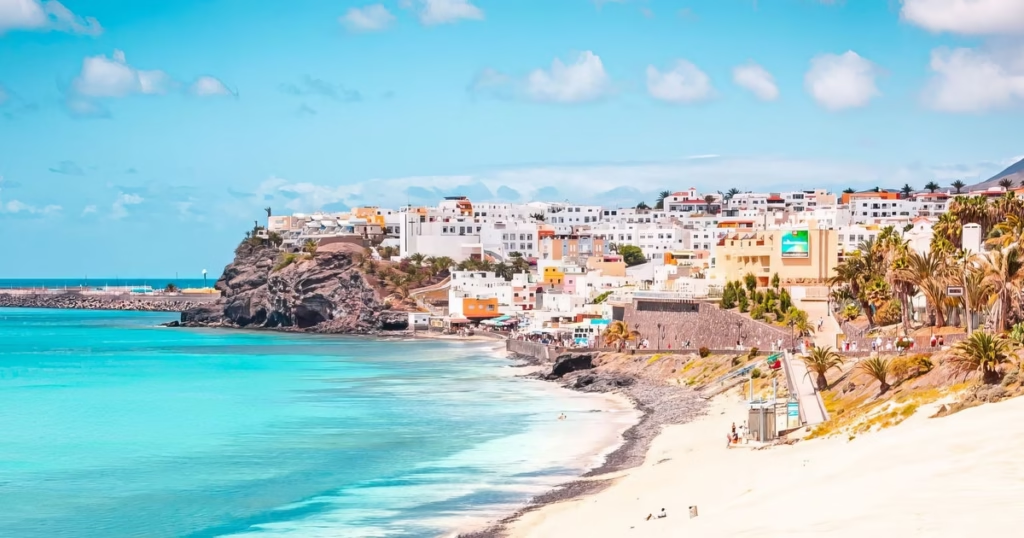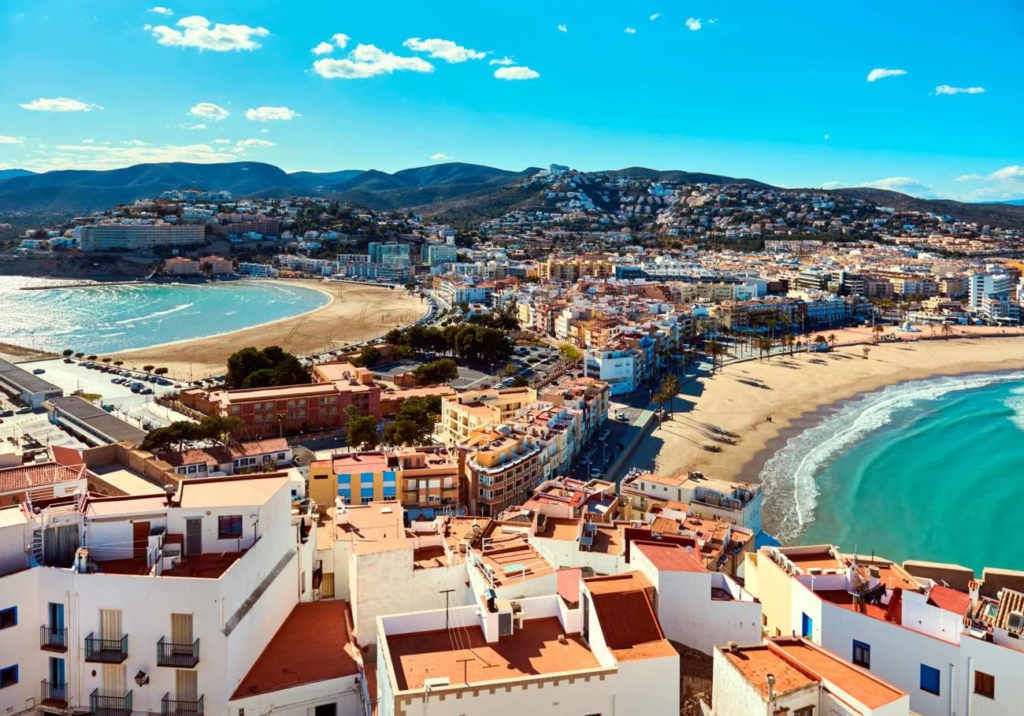Fuerteventura Travel Guide: Discover a Canary Island Paradise
Fuerteventura is a mesmerizing destination in Spain’s Canary Islands. It boasts sun-kissed beaches, dramatic volcanic landscapes, and year-round warm temperatures. Often overshadowed by its neighboring islands, Fuerteventura remains a hidden gem that beckons travelers seeking pristine shorelines and laid-back vibes. Whether you’re looking for water sports, nature exploration, or tranquil relaxation, Fuerteventura delivers it all. This comprehensive travel guide will give you insights into the island’s top attractions, best beaches, local cuisine, and essential tips for planning the perfect trip.

Table of Contents
Why Choose Fuerteventura for Your Next Vacation?
Fuerteventura, the second-largest Canary Island after Tenerife, is renowned for its serene atmosphere, natural beauty, and endless opportunities for outdoor adventure. Here are some compelling reasons to put Fuerteventura on your travel list:
Year-Round Sunshine: With an average temperature of about 24°C (75°F), Fuerteventura is an ideal escape during any season.
Stunning Beaches: Home to some of the best beaches in the Canary Islands, the island offers crystal-clear waters and soft golden sands.
Outdoor Adventures: Ideal for windsurfing, kitesurfing, surfing, and other water sports due to the constant trade winds.
Diverse Landscapes: Volcanic terrain, rolling sand dunes, and rugged mountains make Fuerteventura visually unique.
Relaxed Atmosphere: Quieter than some of its neighboring islands, it’s the perfect place to unwind away from bustling crowds.
The island’s breezy climate and scenic views create a paradise for travelers wanting both relaxation and exploration. Because it’s located off the coast of Africa, Fuerteventura enjoys constant sunshine, minimal rainfall, and warm ocean currents. This climate makes water sports not just possible, but a way of life.
Getting to Fuerteventura
By Air
Most travelers arrive via Fuerteventura Airport (FUE), situated near the capital, Puerto del Rosario. Numerous European carriers offer direct flights, particularly during the peak holiday season from April to October. Budget airlines often have attractive fare deals, especially if you book in advance. Flight times typically range from 3.5 to 4.5 hours from major European cities.
By Ferry
If you’re already in the Canary Islands, you can hop on a ferry from Lanzarote, Gran Canaria, or Tenerife to reach Fuerteventura. The Puerto del Rosario and Corralejo harbors are popular docking points. Ferries provide a scenic way to island-hop and can accommodate cars, making it convenient if you plan to explore Fuerteventura on wheels.
Exploring the Best Beaches in Fuerteventura
Fuerteventura’s biggest draw is its coastline. With over 150 kilometers of beaches, you’ll find everything from secluded coves to broad stretches of sand perfect for surfing. Below are some of the island’s most celebrated shores.
1. Corralejo Grandes Playas
Located on the northern tip near Corralejo Natural Park, these beaches feature rolling sand dunes and turquoise waters. The area is popular for swimming, sunbathing, and water sports such as windsurfing and kiteboarding. Thanks to the consistent winds, you’ll see colorful kites dotting the sky year-round.
2. El Cotillo
Tucked away on the northwest coast, El Cotillo exudes a charming fishing-village vibe. The beaches here are more rugged, offering hidden lagoons framed by volcanic rock. These calm lagoons are perfect for families and novice swimmers looking for a safe environment.
3. Cofete Beach
Set on the wild southwestern coast within the Jandía Natural Park, Cofete Beach is often praised as one of the most beautiful beaches in Spain. It requires a slightly challenging drive on unpaved roads, but you’ll be rewarded with sweeping views and a sense of raw, untouched wilderness. The currents can be strong, so exercise caution if you decide to swim.
4. Sotavento Beach
Situated on the southeastern peninsula of Jandía, Sotavento Beach is famous for hosting international windsurfing and kitesurfing championships. The shifting sandbanks create shallow lagoons, which are ideal for practicing board sports. Even if you’re not into water sports, watching skilled windsurfers glide over the waves is an unforgettable spectacle.
Top Activities and Attractions
Beyond sunbathing on golden sands, Fuerteventura offers abundant opportunities for exploration and adventure. From natural wonders to cultural excursions, the island caters to diverse interests.
1. Corralejo Natural Park
Spanning nearly 2,600 hectares, Corralejo Natural Park features rolling sand dunes that resemble a mini Sahara Desert. The park also includes protected seabeds, so snorkeling is a treat for underwater enthusiasts. You can hike across the dunes or simply marvel at the endless expanse of golden sand against a backdrop of volcanic mountains.
2. Oasis Wildlife Fuerteventura
Located in La Lajita, this conservation-focused park is home to over 3,000 animals and an array of botanical gardens. You can witness live animal shows, enjoy camel rides, or explore the cactus garden. This is an excellent option for families with children.
3. Isla de Lobos
A short ferry ride from Corralejo takes you to Isla de Lobos, a small, uninhabited island. Hike around volcanic landscapes, observe native bird species, or snorkel in crystal-clear waters. Access is regulated to preserve the environment, so you’ll need a permit (often included in the ferry ticket).
4. Ajuy Caves
Visit the Ajuy Caves on the west coast for a glimpse into Fuerteventura’s geological past. Formed by ancient lava flows, these caves offer dramatic ocean views and a rugged path lined with black volcanic sand. The nearby fishing village of Ajuy serves fresh seafood and has a small beach where you can unwind.
5. Betancuria
Originally the island’s capital, Betancuria is a picturesque town nestled in a volcanic valley. Steeped in history, it’s home to the Iglesia de Santa María and the Museum of Sacred Art. Wander the quaint streets and sample local goat cheese at a family-run restaurant. The surrounding landscapes also provide excellent vantage points for photography.
Where to Stay in Fuerteventura
Choosing the right base in Fuerteventura is essential for a memorable vacation. Each region has its own charm:
Corralejo (North)
Why Stay Here? Lively atmosphere, quick access to Corralejo Natural Park, vibrant nightlife, and a good choice of international restaurants.
Who Is It For? Perfect for travelers looking for a blend of beach time and energetic evenings.
Caleta de Fuste (East)
Why Stay Here? Conveniently located near the airport, the resort area offers modern hotels, golf courses, and family-friendly beaches with calm waters.
Who Is It For? Ideal for families and travelers seeking a central location for day trips around the island.
Costa Calma & Morro Jable (South)
Why Stay Here? Closer to Sotavento Beach and Jandía Natural Park. These areas offer upscale resorts, white-sand beaches, and quieter surroundings.
Who Is It For? Great for couples, wellness travelers, and those wanting a tranquil getaway.
El Cotillo (Northwest)
Why Stay Here? A laid-back fishing village atmosphere with beautiful lagoon beaches.
Who Is It For? Ideal for surfers and anyone seeking a relaxed coastal setting far from large tourist crowds.
Local Cuisine and Dining
Fuerteventura’s cuisine is a unique blend of Spanish, African, and Latin American influences. Fresh seafood is abundant, and the local Majorero goat cheese enjoys a protected designation of origin. Here are a few must-try delicacies:
Papas Arrugadas with Mojo: Wrinkled Canarian potatoes served with red and green mojo sauces.
Majorero Cheese: A creamy goat cheese produced locally, often drizzled with honey or served with mojo.
Gofio: A flour made from roasted grains, used in various dishes like soups, stews, and desserts.
Fresh Seafood: Grilled octopus, fried calamari, and the catch of the day are staples in coastal restaurants.
Goat Stew: A slow-cooked local specialty that highlights Fuerteventura’s goat farming traditions.
You’ll find both traditional eateries and international cuisine throughout the island. Puerto del Rosario and Corralejo have a wide array of restaurants. Meanwhile, smaller villages like Betancuria offer authentic dishes made from locally sourced ingredients.
Practical Travel Tips for Fuerteventura
Language: Spanish is the official language, but English and German are widely spoken in tourist areas.
Currency: Fuerteventura uses the euro (€), and most establishments accept credit cards. Cash is useful for small shops and local markets.
Transportation: Renting a car is popular for exploring remote beaches and inland villages. Public buses connect major towns, and taxis are readily available.
Weather: Pack light layers and plenty of sunscreen. Even if it’s not scorching hot, UV rays can be strong.
Water Sports: If you plan to surf or windsurf, many beachside schools offer lessons and gear rentals at competitive prices.
Cultural Etiquette: Greet locals with a warm “hola,” and be respectful when photographing people or religious sites.
Safety: Fuerteventura is generally safe, but always keep an eye on your belongings, especially in crowded tourist hotspots.
Local Events: Look out for traditional fiestas and festivals, which offer a glimpse into Canarian music, dance, and cuisine.
FAQs: Fuerteventura Travel
1. When Is the Best Time to Visit Fuerteventura?
Fuerteventura’s climate is warm and sunny year-round, making it an excellent choice in any season. Winter months are popular among those escaping colder climates, while summer sees an influx of families. If you prefer fewer crowds, consider visiting in spring or autumn.
2. Do I Need a Visa to Visit Fuerteventura?
Fuerteventura is part of Spain, which is in the Schengen Area. EU citizens can travel freely, while non-EU visitors should check visa requirements based on their nationality. Many travelers from North America and certain other regions can enter visa-free for short stays.
3. Is Fuerteventura Good for Families?
Yes. Fuerteventura’s calm beaches, family-friendly resorts, and child-oriented activities like Oasis Wildlife Fuerteventura make it a fantastic destination for families. Caleta de Fuste is especially popular for its shallow waters and kid-friendly amenities.
4. What Are the Top Water Sports on the Island?
Windsurfing, kitesurfing, surfing, and paddleboarding are the most prominent water sports. Sotavento Beach and Corralejo are hotspots for wind-based activities. Local instructors offer lessons for beginners, and advanced riders can enjoy strong winds and challenging waves.
5. How Can I Get Around Fuerteventura?
Car rentals are the most flexible way to explore the island’s remote beaches and scenic drives. Public buses connect major towns like Corralejo, Puerto del Rosario, and Morro Jable. Taxis are available but can be pricier for long distances.
6. What Should I Pack for My Trip?
Pack lightweight, breathable clothing, swimwear, comfortable footwear, and plenty of sunscreen. A light jacket or sweater can be useful for cooler evenings, particularly in winter. If you plan on hiking, bring sturdy shoes and a reusable water bottle.
7. Is Fuerteventura Expensive?
Accommodation and dining prices vary depending on the season and location. You can find budget-friendly apartments and mid-range hotels in towns like Corralejo, while high-end resorts near Costa Calma or Morro Jable may cost more. Eating at local cafés and restaurants is typically more affordable than tourist hotspots.
8. Can I Visit Other Canary Islands from Fuerteventura?
Yes. Ferries run between Fuerteventura and Lanzarote, and there are also routes to Gran Canaria and Tenerife. Island-hopping by ferry is popular for travelers who wish to experience the diversity of the Canary Islands.
Fuerteventura is more than just a beach destination. It’s an immersive experience blending pristine nature, vibrant culture, and outdoor adventure in equal measures. Plan ahead, savor local flavors, and soak up the enchanting charm that only the Canary Islands can provide. Safe travels!
Conclusion: Embrace the Island Vibes
Fuerteventura’s inviting landscapes and calm energy create a paradise for travelers seeking sun, sea, and sand. The island’s rich cultural heritage, flavorful local cuisine, and range of adventurous activities ensure there’s something for everyone. Whether you’re relaxing on a secluded beach, sampling fresh goat cheese in a quaint village, or riding the winds off Sotavento Beach, you’ll find Fuerteventura to be an unforgettable destination.
If you crave an authentic Canary Islands experience that balances tranquility with excitement, Fuerteventura awaits. Pack your sunscreen, reserve a spot on the sand, and let the island’s ocean breezes carry your worries away.

